Herbal medicine hasn’t changed at all. The same plants provide the same medicinal benefits as before, even though most people are unaware of them and leery of their veracity.
In a post-disaster world, herbal medicine may be the only option left to us. When Big Pharma can no longer make and distribute their products to the pharmacies and physicians who dispense them, people will still need medicine. The solution for most will be to turn to the little bit they know or can learn about herbal medicines. Learning about them now merely gives us a head-start.
Meet Purslane
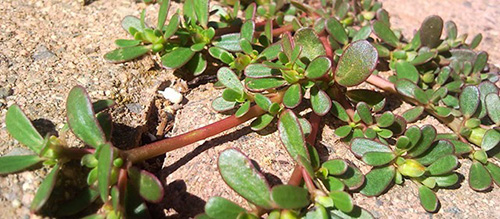 Chances are fairly high that you already have purslane growing somewhere in your yard, this prolific weed grows around the world, and can be found from coast to coast in the Continental United States. About the only place you can’t find it in the USA is in Alaska, where the climate is just too cold for it.
Chances are fairly high that you already have purslane growing somewhere in your yard, this prolific weed grows around the world, and can be found from coast to coast in the Continental United States. About the only place you can’t find it in the USA is in Alaska, where the climate is just too cold for it.
Purslane is a leafy plant, which produces yellow flowers. The stems of the plant are reddish on the top and light green on the bottom. Purslane leaves are spatula shaped and slightly puffy, especially during the summer, which is the best time to harvest them, unless you live in the south, where you can harvest it all year long.
You must be careful not to confuse purslane with the spurge weed, which looks similar, but is poisonous. There are some ways of telling the difference between the two. There are a couple of ways of telling the difference between the two. First, purslane can grow to be 12” to 15” tall, while spurge lays flat on the ground. But this is not definitive as it depends on the growing conditions. The best test is to break the stem and squeeze out a bit of the sap. Spurge will have a milky sap (you shouldn’t eat any plants with a milky sap) and purslane will have a translucent, almost clear one.
As long as you have real purslane, any part of the plant which grows above the ground is safe to eat. It can be eaten raw or cooked in a variety of ways, just as if you were using any other leafy vegetable. The flavor is something like spinach and can be considered a substitute for spinach or watercress in salads and recipes. It can even be pickled to preserve it.
Related: How to Make the Most Powerful Natural Antibiotic
What’s So Special About Purslane?
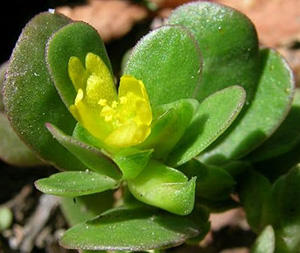 Although we consider purslane a weed, it is one of the most nutritious plants you can find, packed with important micronutrients, while being low on calories. It contains beta-carotene, vitamins A, C and E, as well as some of the B vitamins, magnesium, calcium, potassium, folate, lithium and protein.
Although we consider purslane a weed, it is one of the most nutritious plants you can find, packed with important micronutrients, while being low on calories. It contains beta-carotene, vitamins A, C and E, as well as some of the B vitamins, magnesium, calcium, potassium, folate, lithium and protein.
But the most important thing this vegetable contains, is Omega-3 fatty acids, 8.3 mg for every gram of weight. Nutritionists have long touted the importance of eating fish or taking fish oil, as a source of Omega-3. Purslane provides an even better source of this nutrient for those who can’t or don’t want to eat fish.
It is also an excellent source of melatonin, which helps regulate sleep. Melatonin is an antioxidant, which acts as a hormone. It is naturally found in the body, as a product of the pineal gland. Those who have trouble sleeping often have a low level of melatonin in their bodies, which is normally treated by taking melatonin in tablet form. However, this plant offers levels of melatonin which are as much as 1,000 times higher than that available in any other plant.
What Can Purslane Do?
Purslane is a natural anti-inflammatory, antibacterial and antifungal, much like garlic. This makes it an excellent all-purpose herbal treatment for a variety of different ailments. The list of common ailments that can be treated with purslane, as part of an overall treatment strategy, is impressive:
Skin Problems
- Burns
- Dermatitis (skin irritations)
- Insect stings
- Pruritus (a severe itching of the skin) – this is a symptom of various ailments
- Skin sores
- Abscesses (an area of pus, under the skin, caused by an infection)
- Eczema (white patches of the skin that are rough and inflamed)
Any of these skin problems are best treated by making a poultice and applying it directly to the affected area. To make poultice, grind up enough purslane (leaves and stems) in a mortar and pestle to cover the irritated area. You don’t need a thick coating, an eighth of an inch will do. The key thing is to have enough to cover the entire area. Apply the ground up purslane to the affected area and cover with cloth (a gauze pad works well); then tie in place. You can use an elastic bandage or elastic gauze for this.
Leave the poultice in place for at least 30 minutes. Repeat the treatment two to three times per day. The same poultice can be used up to six times, as long as it is kept moist. However, if it dries out enough that the sap from the leaves is no longer visible, it should be thrown away and replaced.
Related: Lost Remedies from Our Forefathers
Earache
Earaches are normally a form of infection. Due to their location, they are best treated with a tincture, as shown below. Put three to four drops of the tincture in the ear canal and hold in place by stuffing a small piece of a cotton ball into the ear canal. Leave in place for at least 10 minutes, before removing the cotton.
Repeat this treatment three to four times per day, until at least two days after the earache is gone. Please note that the pain will stop before the infection is fully eliminated. That’s why it is necessary to continue treatment after it seems to be healed.
Internal Infections
- Colitis (an inflammation of the large intestine’s lining)
- Dysentery (a bacterial infection of the intestines)
- Enteritis (the inflammation of the small intestine) – which can be caused by viral or bacterial infection, poor blood flow, inflammatory conditions or problems with alcohol or drug abuse
- Fever
- Painful urination – usually caused by an infection
- Shingles (an inflammation of the nerve ganglia in adults, caused by the same virus that causes chicken pox in children)
- Stomach aches – a common bacterial infection
The body’s immune system fights against these internal infections. Purslane can help by augmenting the body’s natural antibodies. To use purslane for internal infections, add about 1/8 cup of purslane leaves (whole or chopped) to salads or vegetables in each meal (three times per day). You can also eat the leaves directly, but it is more flavorful as part of other foods.
Please note that since purslane is a natural herbal remedy, you basically can’t overdose on it, unless you try to make your diet wholly of purslane. Any excess that you eat, over and above what your body needs, will be eliminated as waste.
Other Ailments
- Arthritis
- Diabetes
- Headaches
- Ulcers
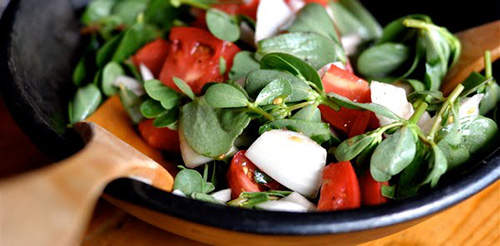 As with infections, treatment of these ailments is best accomplished by adding purslane to the diet, making it part of your salads and vegetable dishes. These are serious conditions, which purslane cannot cure on its own. However, it will help in your body’s fight against them.
As with infections, treatment of these ailments is best accomplished by adding purslane to the diet, making it part of your salads and vegetable dishes. These are serious conditions, which purslane cannot cure on its own. However, it will help in your body’s fight against them.
Please note that there are other conditions for which people have claimed that purslane has made a difference, but these are not confirmed. The ones listed above are conditions where there is enough evidence to show that purslane has made a significant difference in dealing with the condition.
This does not mean, however, that purslane is a miracle cure, which will take care of these conditions with one dose. Most of these conditions need time to heal; but purslane promotes that healing. It also promotes general health, when consumed as a regular part of your diet, helping to prevent these conditions from occurring.
Related: How To Make Tea Tree Oil To Treat Infections
How To Use It
As with many herbal medicines, there are a variety of different ways of using purslane. You can buy dried and crushed purslane, to be taken as a dietary supplement. However, we’re operating under the assumption that you need purslane for survival purposes, where that won’t be available.
For internal infections and other conditions, the purslane is best eaten, either raw or cooked. However, as is typical for vegetables, some percentage of the nutrients come out of the plant while it is being cooked, especially if it is boiled. Using it raw, such as in a salad, ensures that all the nutrients are received.
When using purslane or other herbal medicines for treating skin disorders, burns or insect bites, it is best to make it into a poultice and apply it directly to the affected area, binding it with a cloth. Crush the purslane with a mortar and pestle, before applying, so that the inner part of the leaf and the sap can make contact with the infection. The nutrients will then be absorbed directly through the skin.
Tincture Of Purslane
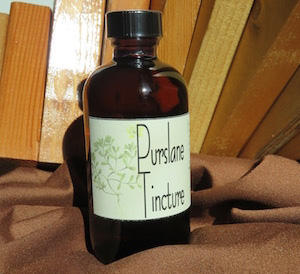 In a few cases, such as earache, it is best to make a tincture out of the herb, creating a concentrated form of the herb (much like essential oil) which can be applied with an eye dropper. This is accomplished by soaking the leaves (preferably crushed leaves) in alcohol, allowing the alcohol to draw out the nutrients. You need a high proof alcohol for this (at least 80 proof) or as an alternate, you can use apple cider vinegar.
In a few cases, such as earache, it is best to make a tincture out of the herb, creating a concentrated form of the herb (much like essential oil) which can be applied with an eye dropper. This is accomplished by soaking the leaves (preferably crushed leaves) in alcohol, allowing the alcohol to draw out the nutrients. You need a high proof alcohol for this (at least 80 proof) or as an alternate, you can use apple cider vinegar.
To make a tincture, crush the leaves and place them in a pint jar, filling the jar 1/3 to ½ of the way full; don’t pack the leaves down. Then fill the jar with alcohol and seal it shut. Store the jar in a cool dry place and shake daily for three weeks or more. When the tincture is done, filter out the leaves and store the final product in a colored dropper bottle.
Tinctures made with alcohol will keep indefinitely, but tinctures made with apple cider vinegar need to be refrigerated. Even then, they will only keep for about six months.
You may also like:
How to Preserve Meat for Two Years Without Refrigeration (Video)
10 Beautiful Plants That Are Secretly Killing Your Garden
All-Natural, Home Remedies for High Blood Pressure
How To Make Survival Dandelion Jelly with 2 Years Shelf Life

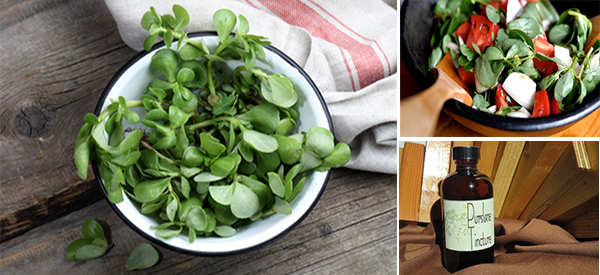
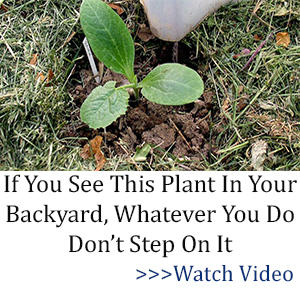













I would suggest you get your facts correct Purslane grows flat on the ground not 12-15 inches high.
Depending on the amount of moisture available, the plant may be quite low-growing or more erect up to 16″ tall.
You can see it here: https://wimastergardener.org/article/common-purslane-portulaca-oleracea/
It can grow high! Spurge radiates out from the center in a circle. Purslane is an erect plant growing upright. Spurge crawls along the ground.
There must be several kinds of spurge. My Leafy Spurge and Blunt Leaf Spurge grow upright in the pasture. Leafy Spurge can be 3 feet tall.
Purslane grows both ways. I live in Michigan and it springs up everywhere not covered by dense grass; especially in poor, sandy soil. loves to grow in flower beds like other “weeds”, sidewalk cracks, etc. It is EASILY distinguished from spurge by this one attribute: Purslane looks like a succulent type of plant (looks like gell-filled, puffy, rubbery leaves & stems). Spurge has flat, paper-thin leaves, nothing rubbery about it, and thin, non-rubbery stems. And spurge lays very flat to the ground, none of it ever sprouts upwards.
I live in Michigan and it grows very low to the ground. maybe it depends on the soil.i always wondered what it was. very good info, i am diabetic and arthur is with me all the time. gonna try this.
The purslane in my garden grows up to a foot high.
Thanks for this informative article! I didn’t realize spurge looks similar to purslane. I’ve been looking at all of it as purslane, and will make sure to do the stem test before ingesting any.
I would to more about weeds.
Check out Greene Deane’s Eat the Weeds Forum on You Tube or subscribe.
“Spurge will have a milky sap (you shouldn’t eat any plants with a milky sap) and purslane will have a translucent, almost clear one.”
So I guess that eliminates dandelion.
Which wild plants are safe to eat is a complicated topic where a small error can have significant, even fatal results.
I took a 12 hour course on edible and medicinal plants of the California coastal plain and the only plant I felt I was able to reasonably identify with any certainty was buckwheat which apparently grows abundantly all over California. Oh, and prickly pear, but I already knew what that looked like. It’s hard to miss in SoCal.
Maybe I am just slow, but the differences between many deadly plants and helpful plants are so subtle that without a lot of guided experiences, I feel it is too easy to make a deadly mistake.
This is a topic that I am very interested in, but unless I make a huge investment in time in it, I don’t see myself becoming expert in it enough to risk the low return in calories. I have several books I purchased, including Nygeres’ book and he is a recognized expert in SoCal and desert plants and the pictures in his book are quite illustrative but even looking at the pictures in his book and what I think is the same plant still leaves me uncertain.
It certainly makes me wish I had started earlier studying plants.
Nygeres even eats the young leaves of poison oak in the springtime to give himself immunity to the mature plants. He claims that’s what the local natives did to immunize themselves against poison oak. They used poison oak vines to make baskets which gave the white man severe poison oak rash. Indians’ revenge, I guess. I think I am immune to poison oak but I don’t put that theory to severe test. My father was immune to poison ivy and would pull it out with his bare hands. I am not that brave. I use rubber gloves if I am handling poison oak and I throw them away when done.
I’m also immune to poison ivy, which is a good thing because a woman would cut through my yard everyday without ever asking permission. She didn’t even introduced herself to me and did not care that I kept telling her to stop. She stopped when I transplanted poison ivy right on her usual route. It has its benefits.
Check out Greene Deane’s Eat the Weeds Forum on You Tube or subscribe.
There must be several kinds of spurge. My Leafy Spurge and Blunt Leaf Spurge grow upright in the pasture. Leafy Spurge can be 3 feet tall.
Interesting article. This type of information is always appreciated, and especially when it is noted which similar plants may be confused with the beneficial one.
Our Purslane has orange flowers. We are in Texas. Does that change the value of the plant?
You say not to eat any plant with a milky sap, but dandelion, the dandelion look alike, and one other plant by the laundry mat had miky sap.
So what is the problem with milky sap?
Web/technical: this email form box overrides when you read and try to write here but I already get your emails.
Can I reduce your emails to once per week?
I am in FairView Park Staten Island NYC NY but many of the plants including purslane are not available behind the fence. On the other side everything is treated with chemicals.
Everyone- please HELP to save this and other land for all generations against these evil greedy foreigners, developers, realtors, religious holy rollers, and other types of social scamsters destroying the land on Staten Island. This is the last of the untouched high ground and the ecology cannot keep up with the toxic air. 50% of the parking lots sit empty everyday. There is no hobby farm remaining in this screwed up shitty with it’s dumb ass dunkle scheis and bleached versions that for one moment can conceive the idea to rack and stack all the social shit out in the cesspool they call an ocean and keep the continent a beautiful varidable wilderness as the anscestors had before the Spanish, Phonecians, French, British/Irish, Mexican invaded killing everyone and using the land as a cutting ground and dumping their toxins. I saw over here personally illegal Mexican, Italian, Irish, Africans, and Chinese are the destructors and get a hard-on over destroying the land. For as much s they push drugs, eat meat, and eat, and overbreed you would think by now that they should have had one moment to Dawn on them that land is life without it there is no life. Bring in a clean sweep because these assholes will infested the entire planet and destroy everything that is good and needed. They didn’t even conceive to grow their damn drugs to cut stupid pain medicines let alone some of these plants are superior food source based on heartiness. When one of you sees there tactics against the consciousness of the people how to use them to override the spiritual will of our anscestors develop a super consciousness because none of these asses are from here and they were clearly greedy assholes in their own land. All true People and those aspiring to be true have been supplanted and subverted. Save the land. Don’t believe that e owe a Goddamned one of them they are stupid, lazy, socializing arrogant asses way overpaid for these eronious cushy created jobs let alone one American should be second to them and the ways of life and life’s necessities. When you destroy the money, these lazy whining asses will go home. Like the alleged Polish man said to me over in green point after swearing up and down he was American,”If the economy doesnt get better than I will just go home.” Like the alleged Mexicaner Said to me over at the alleged Korean deli (twin sister for Chinese)I didn’t want to stay in Mexico if I could come to America and TAKE AN AMERICAN JOB because one American dollar is like 10 Mexican dollars.” I asked, ” Did you stop to think that that one job wasnt just a job it was Americans only way to hold on to the reminants of real life and that one wasn’t enough they needed two, three, or four jobs just to make ends meet?” He replied, “No, I didn’t think about that because that didn’t interest me” I ask him where he was from, he alleged some area, and I said, ” so if 30 million Americans wanted to come down to your city and take over your jobs, force you out, and prevent you from having anywhere to be able to live in your own land that would interest you I bet.” That got his attention because again he couldn’t stay looking straight to my face. When I asked him if he was in the Military he said no but looked down blocking his pupillary reactions. He was clearly bi lingual but yet for his education had no regard for human life, or life’s needs. When you people develop the ability to hear my immediate line and how much shit I have been put through since my child days robbed of me my health and life(4) times dead on the bed this winter for denial of services, jobs, and stealing my and your intellectual work to hand over to infiltrants or out land to worthless asses. hear no excuses, make no exceptions, clean sweep until this foreign alien shit is off this planet. Since16 June 2017 not one Goddamned one of them has come off the ass to return real life let alone join with me but instead steal from me to perpetuate this evil social shit. Clean sweep and don’t stop until you bring back my spirit and that of the White Colored Man/Red Colored Man and give me the resources from them personally to compensate for their goddamned irresponsibility and laziness. Note, make sure you include the rich and the money system so none of these sitting on their ass can have a way to scare within a system. Uncle Ben used a scrit for which he was killed and replaced in England. They found a lot of bones in his basement and when he told them he was using a scrit is when he mysteriously started pushing the revolution. Where money is not evil, it being used allows people to hide. We weren’t allowed don’t allow anyone else.
Interesting post.
Eddie – plants with milky sap tend to be poisonous, bitter, or to upset the stomach. The edible ones generally need to be boiled twice, with the first water thrown out and use fresh water for the second boil.
Poke falls under this category. Very tasty, but even the young leaves are slightly poisonous. The above procedure removes the poison. Other parts of the plant can be highly poisonous, and are not edible.
Notice that this is not true 100% of the time about milky sap. It varies by specific plant, but the rule of thumb is that if the sap is milky don’t eat it.
I can see why you posted all of this, you are afraid all these immigrants who are stealing all the jobs will also take all this abundant plant we have all over the country. I can see why you are upset and worried that Americans will not benefit from the nutrition it offers. Thankyou for the enlightenment you have shared for all of us to think about. SAVE THE PURSLANE
Wannabe – lol.
no one is afraid of immigrants. most of us or our grandparents were (legal) immigrants at one time.
What we don’t want is illegal aliens – get your facts straight…
no borders equals no country.
An illegal alien just raped and murdered a US citizen. That is what we don’t want to happen again. I am not racist in any way… if you think that everyone has a right to be in our country then you are wrong.
May God bless you and change your screwed up mind, brother…
I picked and cut the stem of my purslane…to be sure it WAS purslane.
It had clear liquid when squeezed.
Mine only grows when the weather is dry here.
Long article
When I lived in Fort Wayne, my garden had plenty of purslane. Now I live in the Hoosier National Forest on 25 wonderful acres. …and you’d think I could find it on my place. Nope. I’ve been lookin’ for a number of years now and still haven’t found any. 🙁
Johnny purslaneseed… just a suggestion. 🙂
You could always take a trip back to Ft.Wayne and dig some up and transplant it to your new home.
How can you save it through the winter will it grow in the house and will it freeze
claude, i was thrilled to find purslane in my garden we have for a long time mixed it with dhall and eaten it but i was not aware of all itws other benefits ., really great news .I want to make the tinture too. I am presently drawing a book of all availabllle weeds etc in sri lanka your feed is going to be extra beneficial too Thank you so much,m Much love srahi bongso
As a point of information, it is entirely possible to overdose on herbal remedies, or to have an allergic reaction. Get a good herbal book and read up before experimenting. Low toxicity plants are a good place to start – purslane is one, but use sparingly until you see what your reaction to them is.
Plant the showy hybrid purslanes from garden centers and it will seed your beds profusely with the small flowered native. It’s a nice garnish which is the extent of its usefulness.
Creeping spurge was always on my bad plant list until I saw Salvadorans squeezing the milky sap from the stem directly into the eye to soothe allergies. This caused a bit of panic in my motherly soul, but I was told it is common practice and no one went blind. Also talked to a Vietnamese woman who was gathering it, she said it was useful for thickening soups and sauces. You never know what you don’t know.
beau1954 – message read loud and clear. always something to learn from older and wiser….
me getting wiser is having trouble keeping up with me getting older these days…
Beau1954
😉
The above article should include a caution related to high level of oxalic acid in purslane “…When oxalic acid combines with calcium and some of these other minerals it creates oxalate crystals, which can contribute to kidney stones…” http://www.eatthatweed.com/oxalic-acid/
see also https://www.researchgate.net/publication/268439013_Oxalate_content_of_raw_and_cooked_purslane
I have this book and am well aware of purslane. My son and I took an edible plants course years ago in Mt. Aetna, Maryland. It was eye opening?